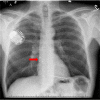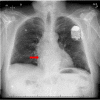"Two for the Price of One": A Single-Lead Implantable Cardioverter-Defibrillator System with a Floating Atrial Dipole
- PMID: 27909501
- PMCID: PMC5089476
- DOI: 10.4022/jafib.1396
"Two for the Price of One": A Single-Lead Implantable Cardioverter-Defibrillator System with a Floating Atrial Dipole
Abstract
In patients known to be a high risk for sudden cardiac arrest, implantable cardioverter defibrillators (ICD) are a proven therapy to reduce risk of death. However, in patients without conventional indications for pacing, the optimal strategy for type of device, dual- versus single-chamber, remains debatable. The benefit of prophylactic pacing in this category of patients has never been documented. Although available atrial electrograms in a dual chamber system improve interpretation of stored arrhythmia events, allow monitoring of atrial fibrillation and may potentially reduce the risk of inappropriate shocks by enhancing automated arrhythmia discrimination, the use of dual-chamber ICDs has a number of disadvantages. The addition of an atrial lead adds complexity to implantation and extraction procedures, increases procedural cost and is associated with a higher risk of periprocedural complications. The single lead pacing system with ability to sense atrial signals via floating atrial electrodes (VDD) clinically became available in early 1980's but did not gain much popularity due to inconsistent atrial sensing and concerns about the potential need for an atrial lead if sinus node fails. Most ICD patients do not have indications for pacing at implantation and subsequent risk of symptomatic bradycardia seems to be low. The concept of atrial sensing via floating electrodes has recently been revitalized in the Biotronik DX ICD system (Biotronik, SE & Co., Berlin, Germany) aiming to provide all of the potential advantages of available atrial electrograms without the risks and incremental cost of an additional atrial lead. Compared to a traditional VDD pacing system, the DX ICD system uses an optimized (15 mm) atrial dipole spacing and improved atrial signal processing to offer more reliable atrial sensing. The initial experience with the DX system indicates that the clinically useful atrial signal amplitude in sinus rhythm remains stable over time. Future studies are needed to determine reliability of atrial sensing during tachyarrhythmias, particularly atrial fibrillation as well as clinical utility and cost-effectiveness of this technology in different populations of patients.
Keywords: DX ICD System; Floating Atrial Electrodes; Implantable Cardioverter-Defibrillator; VDD Pacing.
Figures








Similar articles
-
Long-Term Stability and Clinical Utility of Amplified Atrial Electrograms in a Single-Lead ICD System with Floating Atrial Electrodes.Pacing Clin Electrophysiol. 2016 Dec;39(12):1327-1334. doi: 10.1111/pace.12967. Epub 2016 Nov 20. Pacing Clin Electrophysiol. 2016. PMID: 27778352
-
Implantable cardioverter defibrillator system with floating atrial sensing dipole: a single-center experience.Pacing Clin Electrophysiol. 2014 Oct;37(10):1265-73. doi: 10.1111/pace.12421. Epub 2014 May 9. Pacing Clin Electrophysiol. 2014. PMID: 24809851
-
Subclinical atrial fibrillation detection with a floating atrial sensing dipole in single lead implantable cardioverter-defibrillator systems: Results of the SENSE trial.J Cardiovasc Electrophysiol. 2019 Oct;30(10):1994-2001. doi: 10.1111/jce.14081. Epub 2019 Aug 5. J Cardiovasc Electrophysiol. 2019. PMID: 31328298 Free PMC article. Clinical Trial.
-
Rationale and feasibility of the atrioventricular single-lead ICD systems with a floating atrial dipole (DX) in clinical practice.Trends Cardiovasc Med. 2022 Feb;32(2):84-89. doi: 10.1016/j.tcm.2021.01.003. Epub 2021 Jan 19. Trends Cardiovasc Med. 2022. PMID: 33482321 Review.
-
The utilization of atrial sensing dipole in single lead implantable cardioverter defibrillator for detection of new-onset atrial high-rate episodes or subclinical atrial fibrillation: A systematic review and meta-analysis.J Arrhythm. 2022 Jan 15;38(2):177-186. doi: 10.1002/joa3.12675. eCollection 2022 Apr. J Arrhythm. 2022. PMID: 35387136 Free PMC article. Review.
Cited by
-
Bilateral Cardiac Sympathectomy and Extrapericardial Coil Implantation for the Management of Electrical Storm.JACC Case Rep. 2021 Mar 17;3(3):491-495. doi: 10.1016/j.jaccas.2020.12.029. eCollection 2021 Mar. JACC Case Rep. 2021. PMID: 34317565 Free PMC article.
-
Arrhythmia Detection in Atrioventricular, Single-Lead, Floating Atrial Dipole ICD Systems Compared with Conventional Single- and Dual-Chamber Defibrillators.J Cardiovasc Dev Dis. 2024 Dec 1;11(12):386. doi: 10.3390/jcdd11120386. J Cardiovasc Dev Dis. 2024. PMID: 39728276 Free PMC article.
-
Predicting worsening heart failure hospitalizations in patients with implantable cardioverter defibrillators: is it all about alerts? A pooled analysis of nine trials.Europace. 2024 Feb 1;26(2):euae032. doi: 10.1093/europace/euae032. Europace. 2024. PMID: 38291778 Free PMC article.
-
Clinical safety of the ProMRI implantable cardioverter-defibrillator systems during head and lower lumbar magnetic resonance imaging at 3 T: results of the ProMRI 3T ENHANCED Master study.Europace. 2019 Nov 1;21(11):1678-1685. doi: 10.1093/europace/euz189. Europace. 2019. PMID: 31322701 Free PMC article.
-
Ability to remotely monitor atrial high-rate episodes using a single-chamber implantable cardioverter-defibrillator with a floating atrial sensing dipole.Europace. 2023 May 19;25(5):euad061. doi: 10.1093/europace/euad061. Europace. 2023. PMID: 37038759 Free PMC article.
References
-
- Peterson Pamela N, Varosy Paul D, Heidenreich Paul A, Wang Yongfei, Dewland Thomas A, Curtis Jeptha P, Go Alan S, Greenlee Robert T, Magid David J, Normand Sharon-Lise T, Masoudi Frederick A. Association of single- vs dual-chamber ICDs with mortality, readmissions, and complications among patients receiving an ICD for primary prevention. JAMA. 2013 May 15;309 (19):2025–34. - PMC - PubMed
-
- Wilkoff Bruce L, Cook James R, Epstein Andrew E, Greene H Leon, Hallstrom Alfred P, Hsia Henry, Kutalek Steven P, Sharma Arjun. Dual-chamber pacing or ventricular backup pacing in patients with an implantable defibrillator: the Dual Chamber and VVI Implantable Defibrillator (DAVID) Trial. JAMA. 2002 Dec 25;288 (24):3115–23. - PubMed
-
- Olshansky Brian, Day John D, Moore Stephen, Gering Lawrence, Rosenbaum Murray, McGuire Maureen, Brown Scott, Lerew Darin R. Is dual-chamber programming inferior to single-chamber programming in an implantable cardioverter-defibrillator? Results of the INTRINSIC RV (Inhibition of Unnecessary RV Pacing With AVSH in ICDs) study. Circulation. 2007 Jan 2;115 (1):9–16. - PubMed
-
- Wilkoff Bruce L, Kudenchuk Peter J, Buxton Alfred E, Sharma Arjun, Cook James R, Bhandari Anil K, Biehl Michael, Tomassoni Gery, Leonen Anna, Klevan Linette R, Hallstrom Alfred P. The DAVID (Dual Chamber and VVI Implantable Defibrillator) II trial. J. Am. Coll. Cardiol. 2009 Mar 10;53 (10):872–80. - PubMed
-
- Sweeney Michael O, Ellenbogen Kenneth A, Tang Anthony S L, Whellan David, Mortensen Peter T, Giraldi Francesco, Sandler David A, Sherfesee Lou, Sheldon Todd. Atrial pacing or ventricular backup-only pacing in implantable cardioverter-defibrillator patients. Heart Rhythm. 2010 Nov;7 (11):1552–60. - PubMed
Publication types
LinkOut - more resources
Full Text Sources
Medical
